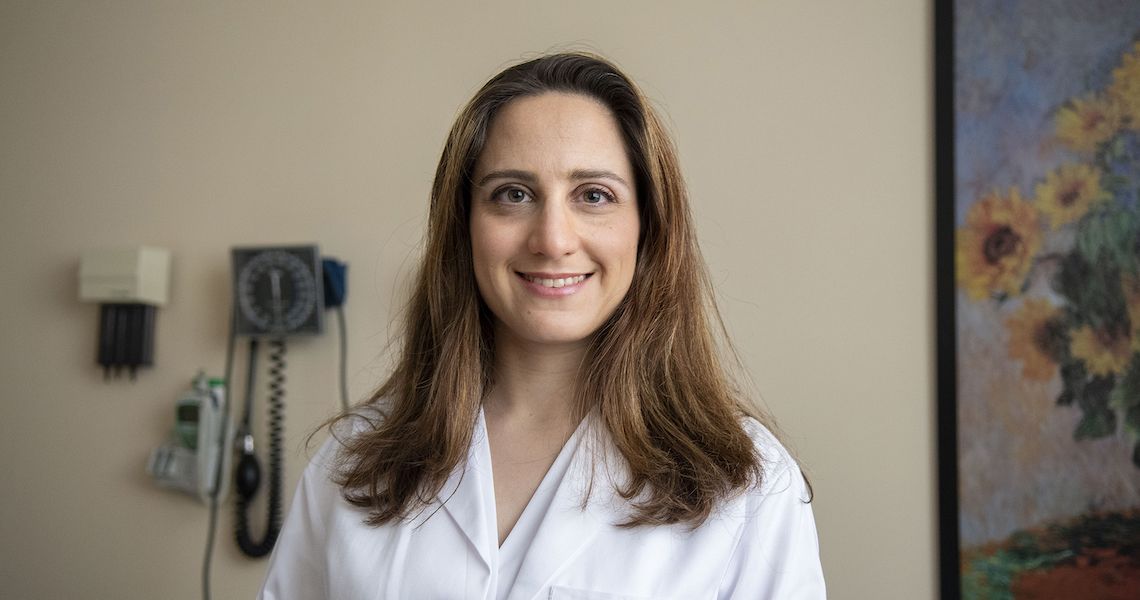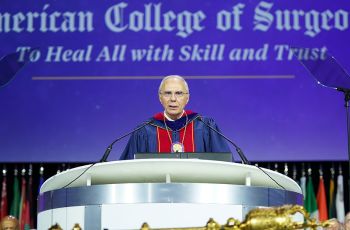If Shakespeare is right, that the eye is the window to the soul, then could corneal transplants allow the soul to see and be seen with greater clarity? Either way, corneal transplants are unique among transplantation: almost anyone can donate, transplants are highly successful, and the risk of rejection is low. In 2021, for instance, close to 80,000 corneas were used for transplantation in the United States, with a $5.8 billion lifetime economic benefit, according to the Eye Bank Association of America. Here, Maya Bitar, MD, associate professor of ophthalmology at the George Washington University (GW) School of Medicine and Health Sciences, explains the ins-and-outs of corneal transplantation and how technology has advanced.
What is a corneal transplantation?
Bitar: First, the cornea is the transparent layer in the front of the eye; it's like the window of the eye. The cornea itself has multiple layers ranging from the epithelium on the outer surface to the endothelium on the inner side. Each layer must be healthy and clear to maintain a clear regular cornea and allow clear vision. When the cornea is too cloudy or distorted, a corneal transplantation surgery may be needed to be able to see. It consists of replacing one or all parts of the cornea.
Who needs a corneal transplantation?
Bitar: Different conditions can cause permanent scarring or clouding of the cornea, resulting in low vision and a need for a corneal transplant. Infections and trauma to the eyes can cause severe scarring of the cornea. Some genetic diseases, what we call “dystrophies,” can cause clouding or opacification of corneas. The most common one is Fuchs’ corneal dystrophy, which usually starts manifesting after age 40. Keratoconus is another relatively common condition that leads to irregularity and thinning of the cornea and may necessitate corneal transplantation even in younger patients. In addition, patients who undergo multiple or complicated eye surgeries may get weakness and swelling of their cornea, [thus] needing a surgery.
What should patients know about getting a corneal transplant?
Bitar: Corneal transplantation surgery has evolved a lot. Overall, the success rate is 95%, but it varies according to how severe the corneal disease is and how sick the eye is. Getting a corneal transplant is not only a life-changing procedure but also a lifelong commitment. It is one of the most important things that patients need to realize in order to get a good outcome. There are long-term eyedrops, precautions, and follow-up visits that are required. In a way, they receive a gift from a donor that they will need to honor.
What is the risk of rejection, and what does an anti-rejection regimen look like?
Bitar: The risk of rejection in corneal transplantation is much lower than for other organs of the body. We don’t even need to match the donor to the receiver. Just one drop of corticosteroid medication can prevent rejection in the long term in most cases. For some patients, that may not be enough, and they may get an episode of rejection. This rejection can occur several months to several years following surgery. It is generally reversible if addressed quickly, thus the importance of patients being alert to the signs and following up with their ophthalmologist urgently. Usually, [the rejection] responds to eyedrops, and rarely do we end up needing oral or intravenous anti-rejection medications.
How has technology advanced corneal transplantation?
Bitar: In the past, around 20 years ago, any time you had a problem in your cornea that needed a transplant, you would get full transplant, meaning replacing the whole cornea. It would require many stitches, a long surgery, and six months to a year for full recovery. Now, we can replace just the part of the cornea that has the problem. Let’s say you have a problem in the front of the cornea; we can just replace the front. If the problem is in the back, we can just replace the back. This really minimizes the risk of long-term complications, and the recovery is much faster.
For instance, in the case of Fuchs’ corneal dystrophy, which causes weakness of the endothelial cells on the inside of the cornea, we can transplant just that same layer with healthy endothelial cells, a very, very thin section of the cornea, like 10-micron thick. It has given us amazing results, and patients’ vision can return to 20/20 within a month. This procedure is called Descemet Membrane Endothelial Keratoplasty, or DMEK.
In the future, we may just need to transplant the cells themselves. There is a lot of exciting research going on in the field.
What is the recovery like for corneal transplants?
Bitar: Recovery will depend on what kind of surgery the patient gets. As mentioned, if we must do a full transplant, the recovery is slow; it can take six months to a year. That’s why the DMEK technique is so exciting. Its downside is that patients have to lie flat on their back for few days after the surgery.
Switching to the donor side, can anyone donate, including glasses-wearers?
Bitar: Wearing glasses by itself does not preclude the possibility to donate. Most people can donate. I would encourage everybody to be a donor, and at the time of death, the Eye Bank will determine if your corneas are eligible. Criteria and helpful information can be found from the Eye Bank Association of America. It used to be if you had LASIK that your corneas couldn’t be used for transplantation. Now, since we are performing partial transplants, we can still use the back layers of these corneas. Even if your cornea can’t serve for transplantation, it can still be used for research or training, which is very much needed, too.
How can you encourage people to donate?
Bitar: Sight is considered the most precious sense. Blindness has a high social and economic burden. As a donor or as the family of a donor, you are giving the gift of sight to not only one but to two persons, since each cornea goes to a different patient. With the success rate so high, this donation will be changing the life of two persons and their family. It can be very rewarding for you and your loved ones to know you had that impact.
To make an appointment with an ophthalmologist, visit the GW Medical Faculty Associates Department of Ophthalmology or call 202-741-2800.




